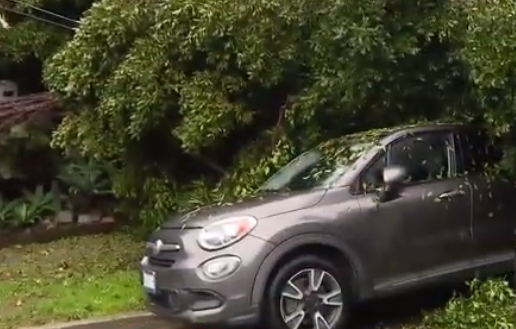California Battling Nature’s Wrath: Coping with a Series of Natural Disasters
California, renowned for its diverse terrain and mild weather patterns, is presently grappling with a series of natural calamities that have rattled communities statewide. From inundations to landslides, California finds itself confronting a potent storm system wreaking havoc along its coastal and mountainous regions. This sustained assault, attributed to an atmospheric river phenomenon, has unleashed not only copious rainfall but also destructive winds and substantial snowfall, testing the fortitude of residents and emergency responders alike.
As the state enters its third day under the grip of this atmospheric river, the situation remains grim, with persistent moderate to heavy rains besieging various locales. Particularly affected are the mountains north of Santa Barbara, where precipitation levels are nearing record-breaking levels. The forecast paints another day of sporadic heavy downpours and isolated thunderstorms, exacerbating the already perilous conditions.
The atmospheric river phenomenon, often delineated as a lengthy, narrow conduit of concentrated moisture in the atmosphere, is culpable for the intense precipitation afflicting California. These atmospheric rivers have the capacity to convey vast volumes of water vapor from the tropics to higher latitudes, resulting in copious rainfall and, in some instances, extreme weather phenomena. While they constitute a natural facet of the Earth’s climate system, their repercussions can be severe, especially upon landfall in regions predisposed to flooding and landslides, such as California.
Beyond the immediate hazards posed by flooding and landslides, the storm system has ushered in destructive winds across certain areas of the state. Strong winds can exacerbate the impact of heavy rainfall by toppling trees and power lines, precipitating power outages and property damage. In mountainous terrains, fierce winds can induce blizzard-like conditions, rendering travel hazardous and amplifying the risk of avalanches.
Substantial snowfall has also been documented in elevated areas, compounding the challenges confronting residents and emergency responders. While snow constitutes a vital water source for California’s water reservoirs, heavy snowfall can prompt road closures, disrupt transportation grids, and heighten the peril of avalanches. Mountainous communities are particularly vulnerable during such tempests, as access to essential amenities and provisions may be curtailed.
The widespread repercussions of the storm system have compelled authorities to issue flood watches and warnings across much of California. From the coastal enclaves of Eureka to the agricultural hub of the Central Valley, millions of inhabitants are on alert for potential flooding and flash flood incidents. Emergency response teams are on high alert, primed for swift water rescues and evacuations if exigencies arise.
The looming threat is anticipated to persist in the ensuing days, as the storm system shows no signs of relenting. With further heavy rainfall predicted, the jeopardy of flooding and landslides remains acute, particularly in regions already saturated by days of precipitation. In addition to the immediate hazards, there are apprehensions regarding the enduring ramifications of the storms, encompassing infrastructural damage, disruption of transportation networks, and plausible environmental repercussions.
Despite the adversities posed by the storm system, Californians have exhibited resilience in the face of adversity. Communities have rallied together to lend support to those in distress, extending assistance and collaborating to mitigate the impact of the storms. Emergency response units have been toiling incessantly to ensure the safety and welfare of residents, conducting rescue missions and furnishing essential services to affected areas.
As California persists in weathering the onslaught, it underscores the significance of preparedness and resilience in confronting natural disasters. With climate change anticipated to engender more frequent and severe extreme weather occurrences in the future, it is imperative for communities to invest in infrastructure, bolster emergency response capacities, and fortify disaster preparedness initiatives. Through concerted efforts and preemptive measures to diminish risk, Californians can forge a more resilient future for themselves and posterity.
Safety Measures for Citizens:
- Stay Informed: Keep abreast of weather updates and heed warnings issued by local authorities through radio, television, or mobile alerts.
- Prepare an Emergency Kit: Assemble a well-stocked emergency kit containing essential supplies such as water, non-perishable food, medications, flashlights, batteries, and a first-aid kit.
- Develop an Evacuation Plan: Familiarize yourself with evacuation routes and have a plan in place for evacuating safely, including arrangements for pets and livestock if applicable.
- Secure Property: Trim trees and remove dead branches to minimize the risk of them falling during high winds. Secure outdoor furniture, equipment, and loose objects that could become projectiles in strong winds.
- Avoid Flood-prone Areas: Refrain from driving or walking through flooded areas, as even shallow water can pose a significant hazard. Be cautious of rapidly rising water levels and seek higher ground if necessary.
- Communicate with Neighbors: Keep in touch with neighbors, especially vulnerable individuals such as the elderly or those with disabilities, to ensure their safety and offer assistance if needed.
- Monitor Water Levels: Keep an eye on nearby water bodies for signs of rising levels and be prepared to evacuate if instructed by authorities.
- Stay Clear of Landslide Risk Areas: Be vigilant in areas prone to landslides, such as steep slopes or areas with loose soil, and evacuate if advised to do so.
- Maintain Communication Devices: Ensure that mobile phones and other communication devices are fully charged and have alternative power sources available in case of power outages.
- Follow Official Instructions: Adhere to directives issued by local authorities and emergency services, including evacuation orders and shelter-in-place instructions, for your safety and that of your community.

